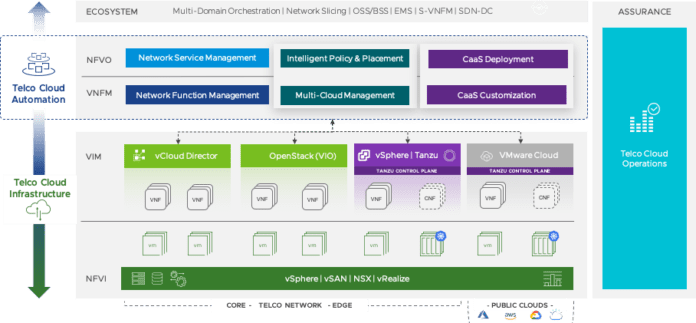5G Telco Cloud Platform follows VMware/Intel partnership on RAN virtualization
Operators have for years invested in virtualization of network functions, starting with the evolved packet core and now moving out to the radio access network. Most current 5G deployments are non-standalone meaning a 5G component carrier is interworked with an LTE RAN and core. The next step is transition of the core to a cloud-native, standalone architecture which opens up new 5G features (and revenue opportunities) like network slicing and autonomous optimization.
Drawing on its cloud infrastructure expertise, VMware today announced its 5G Telco Cloud Platform; the company said the solution set comprises “an embedded Kubernetes distribution” to let service providers “build, manage and run containerized workloads across private, telco, edge and public clouds;” a Telco Cloud Platform that combines mutli-cloud management; and VMware Telco Cloud Automation for “multi-domain orchestration and automation.”
VMware’s Shekar Ayyar, EVP and GM of the Telco and Edge Cloud Business Unit, said in a statement the idea is to facilitate the shift to cloud-native networks so operators “can now boost their innovation speed to deliver new applications and services, reduce operational complexities, and realize substantial total cost of ownership savings, further accelerating the rollout of their 5G networks.”
The idea of inter-mingling virtualized network functions and cloud-native network functions is key in the shift from non-standalone to standalone 5G. For instance, T-Mobile currently has a standalone nationwide 5G network using its 600 MHz spectrum and a non-standalone 5G network using 2.5 GHz spectrum that came with its merger with Sprint.
In response to questions from RCR Wireless News, VMware’s Misbah Mahmoodi, senior director of product marketing, explained that its Telco Cloud Platform lets service providers run VNFs and CNFs “across a consistent horizontal architecture. This common platform allows CSPs to continue to run existing services, such as vEPC and have the same platform support new, cloud-native services, including standalone 5G services. With Telco Cloud Automation, CSPs have a cloud-first network orchestration and automation platform that allows CSPs to automate operations across multiple clouds as well as onboard and orchestrate workloads seamlessly from virtual machine…and containers-based infrastructures and also distribute workloads running from core to edge to RAN.”
To that RAN piece, there’s increasing adoption of vRAN architectures, as well as open radio interfaces; this lets operators swap out single-vendor radio stacks with multi-vendor kit. The idea is to distribute general-purpose compute throughout the network, furthering the “cloudification” of telco networks, creating operational and service flexibility, and creating new service-based revenue opportunities while decreasing carrier capex and opex.
VMware is working with Intel to use the latter’s FlexRAN software reference architecture alongside its own RAN Intelligent Controller to “essentially [take] a lot of the integration risk out of the system and make sure these things work well before they even hit the operator,” VMware’s Sachin Katti explained in a recent interview.
As it pursues a greenfield 5G network deployment, DISH is working with VMware to test CNFs from a number of different vendors using VMware’s Telco Cloud. DISH EVP and Chief Network Officer Marc Rouanne said in a statement that its cloud-first approach “will help us provide our customers with solutions that are more secure, agile and cost-effective. The cloud-native, software-defined nature of the VMware Telco Cloud will also support the DISH ecosystem of partners to accelerate 5G leadership in the U.S.”
To tie together the shift of telco networks to distributed cloud environments with the VNF to CNF shift and what that means for revenue opportunities, Mahmoodi explained: “We have seen IT adapt cloud-native principles which include adapting agile development processes along with DevOps that brings a faster and iterative manner of developing and delivering services, as well as having the ability to adjust and modify services based on changing customer requirements. The use of cloud native networks will give CSPs more control of their applications and provide increased programmable and automated networks to again bring increased agility and accelerate the time to revenue…VMware’s Telco Cloud Platform with multi-layer lifecycle management improves operational efficiency by automation the provisioning and management of all the layers of the telco cloud, from network services to infrastructure, enabling CSPs to reduce provisioning and maintenance costs.”

